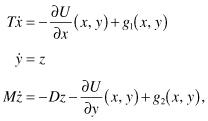Chapter 15
Numerical Network-Reduction BCU Method
15.1 INTRODUCTION
The fundamental ideas behind the conceptual network-reduction BCU method are explained in the following. We are given a generic network-reduction model described below, which encompasses the existing network-reduction models:
(15.1)

where x ∈ Rn, y ∈ Rn, and z ∈ Rn are state variables. T is a positive definite matrix and M and D are diagonal positive definite matrices. The vectors g1(x, y), g2(x, y) represent the transfer conductances. The following artificial, reduced-state model associated with the original model has been shown to satisfy the static properties (S1) and (S2) as well as the dynamic properties (D1), (D2), and (D3):
These properties have been explored to develop a conceptual network-reduction BCU method for computing the controlling unstable equilibrium point (controlling UEP). The reduced-state model is not unique. In the BCU method, a model can be a reduced-state model as long as it satisfies the static and dynamic properties.
There are several possible ways to numerically implement the conceptual network-reduction BCU method. In this chapter, a numerical network-reduction BCU method is presented, explained in great detail, and applied, for illustrational purposes, to several ...


